Vigo
Vigo (/ˈviːɡoʊ/, Galician: [ˈbiɣʊ], locally [ˈbiħʊ], Spanish: [ˈbiɣo]) is a city and municipality in the province of Pontevedra, within the autonomous community of Galicia, Spain. Located in the northwest of the Iberian Peninsula, it sits on the southern shore of an inlet of the Atlantic Ocean, the Ria de Vigo, the southernmost of the so-called Rías Baixas.
Vigo | |
|---|---|
 | |
 Flag 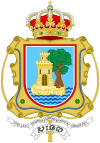 Coat of arms | |
| Nickname(s): The Olive City | |
 Vigo Location within Spain  Vigo Location within Europe | |
| Coordinates: 42.231356°N 8.712447°W | |
| Country | Spain |
| Autonomous community | Galicia |
| Province | Pontevedra |
| Government | |
| • Type | Ayuntamiento |
| • Body | Concello de Vigo |
| • Mayor | Abel Caballero (PSdeG-PSOE) |
| Area | |
| • Municipality | 109.1 km2 (42.1 sq mi) |
| Elevation | 0 m (0 ft) |
| Population (2018)[1] | |
| • Municipality | 293,642 |
| • Density | 2,700/km2 (7,000/sq mi) |
| • Metro | 481,268 |
| Demonym(s) | Vigoan vigués (m), viguesa (f) olívico (m), olívica (f) |
| Time zone | UTC+1 (CET) |
| • Summer (DST) | UTC+2 (CEST) |
| Postcode | 36200-36392 |
| Area code(s) | +34 986 |
| Website | hoxe |
The municipality has an area of 109.06 km2 (42.11 sq mi) and a population of 295,364 in 2019, making it the most populous city in Galicia.
Vigo is one of the region's primary economic agents, owing in part to the French Citroën automotive factory and to the Port of Vigo.[2] Close to the Portugal–Spain border, Vigo is part of the Galicia–North Portugal Euroregion. The European Fisheries Control Agency is headquartered in Vigo.
History
In the Middle Ages, the small village of Vigo was part of the territory of Galician-speaking neighbouring towns, particularly Tui, and suffered several Viking attacks. However, its number of inhabitants was so small that, historically, it was not considered a real villa until around the 15th century, when the earliest records began.
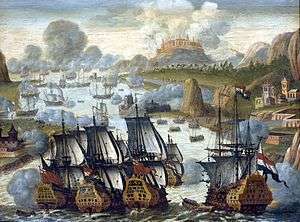
In the 16th and 17th centuries, the city was attacked several times. In 1585 and 1589, during an unsuccessful attack by the English counter-Armada, Francis Drake raided the city and temporarily occupied it, burning many buildings. Several decades later a Turkish fleet tried to attack the city. As a result, the city's walls were built in 1656 in the reign of Philip IV of Spain. They are still partially preserved.
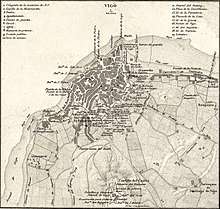
At this time, and in spite of the attacks, Vigo developed its earliest commerce and was given several privileges by the kings of Spain.
In 1702, the Battle of Vigo Bay occurred, and in 1719, because a Spanish fleet which departed from Vigo attempted to invade Scotland in support of the Jacobites, the city was occupied for ten days by a British force.
In 1808, the French Army annexed Spain to the Napoleonic Empire, although Vigo remained unconquered until January, 1809. Vigo was also the first city of Galicia to be freed from French rule, in what is annually celebrated on March 28 as the Reconquista (reconquest from the French in the context of the Peninsular War). In 1833, the city of Pontevedra was designated the provincial capital of the province of Pontevedra, within which is Vigo.
Vigo grew very rapidly in the 20th century thanks to the fact that the Franco government granted it a tax-free zone in 1947 so that companies could set up there for free and an Industrial Development Pole in 1964, a very unusual case for a non-capital of a Spanish province. Continuous urban-planning changes left Vigo less structured than other Galician cities such as Pontevedra and A Coruña.
Toponym
.jpg)
Vigo's urban area is built over both a hill-fort (Castro) and a Roman settlement. It is generally accepted that the name Vigo is derived from the Latin word vicus spacorum, meaning "small village".
The standard pronunciation of Vigo in both Galician and Spanish is [ˈbiɣo].
Vigo has been given the nickname cidade olívica (city of olives). It is said that, after the conflict between the Isabel de Castilla and Juana la Beltraneja—where Galician nobility fought for the latter—the victor ordered all of Galicia's olive trees to be cut down, as they symbolized peace. She couldn't uproot the tree in Vigo, however, because it was planted in sacred ground. The tree is represented in the city seal, and a descendant of it is still alive in Vigo's city centre.
Geography
Location
In the northeast, it borders the municipality of Redondela; in the east, Mos; in the south, O Porriño and Gondomar; and in the southwest, Nigrán. On the other side of its bay are the municipalities of Cangas and Moaña.
Climate

Vigo's climate is usually classified as oceanic (Köppen climate classification Cfb). Although Vigo is the rainiest city in Galicia, in actuality, with its noticeable drying trend in the summer, Vigo's climate is more similar to the variant of the oceanic climate commonly seen in the Pacific Northwest region of North America. Substantial rainfall throughout the year prevents it from being classified as a Mediterranean climate, even though there is a drying trend in summer. The average annual temperature in Vigo is 14 °C (57 °F). Compared to many other Galician towns, Vigo and Pontevedra experience warmer summer temperatures than A Coruña or Santiago de Compostela and milder winters than inland areas. This is due to its sheltered location, surrounded by mountains inland and the Illas Cíes out in the bay towards the sea.[3] The all-time record high for the city is 39.7 °C (103 °F) set on July 5, 2013.[4] Vigo is known for its extreme rainfall in winter. December 1978 saw 925.6 millimetres (36.44 in) fall at the weather station in a single month.[5][6] During that month on 7 December, 175 millimetres (6.9 in) fell on a single day.[7] Normal values for 1981-2010 was 1,791 millimetres (70.5 in) falling on just 129.2 days indicating heavy rain to be common.[8] The airport where values are taken is at a higher elevation than the city centre, which likely is warmer year-round.
| Climate data for Vigo (Vigo Airport 261m) (1981-2010) | |||||||||||||
|---|---|---|---|---|---|---|---|---|---|---|---|---|---|
| Month | Jan | Feb | Mar | Apr | May | Jun | Jul | Aug | Sep | Oct | Nov | Dec | Year |
| Record high °C (°F) | 21.8 (71.2) |
27.6 (81.7) |
28.0 (82.4) |
29.6 (85.3) |
33.6 (92.5) |
38.6 (101.5) |
39.7 (103.5) |
37.8 (100.0) |
36.0 (96.8) |
30.5 (86.9) |
24.5 (76.1) |
23.2 (73.8) |
39.7 (103.5) |
| Average high °C (°F) | 11.9 (53.4) |
13.2 (55.8) |
15.7 (60.3) |
16.6 (61.9) |
18.8 (65.8) |
22.5 (72.5) |
24.4 (75.9) |
24.7 (76.5) |
22.8 (73.0) |
18.8 (65.8) |
14.9 (58.8) |
12.4 (54.3) |
18.0 (64.4) |
| Daily mean °C (°F) | 8.6 (47.5) |
9.6 (49.3) |
11.5 (52.7) |
12.4 (54.3) |
14.6 (58.3) |
17.9 (64.2) |
19.6 (67.3) |
19.8 (67.6) |
18.3 (64.9) |
15.0 (59.0) |
11.5 (52.7) |
9.3 (48.7) |
14.0 (57.2) |
| Average low °C (°F) | 5.4 (41.7) |
5.8 (42.4) |
7.3 (45.1) |
8.2 (46.8) |
10.4 (50.7) |
13.2 (55.8) |
14.8 (58.6) |
15.0 (59.0) |
13.8 (56.8) |
11.2 (52.2) |
8.2 (46.8) |
6.3 (43.3) |
9.9 (49.8) |
| Record low °C (°F) | −4.0 (24.8) |
−5.0 (23.0) |
−3.0 (26.6) |
−0.2 (31.6) |
2.0 (35.6) |
4.6 (40.3) |
7.6 (45.7) |
7.2 (45.0) |
5.0 (41.0) |
1.0 (33.8) |
−0.8 (30.6) |
−3.4 (25.9) |
−5.0 (23.0) |
| Average precipitation mm (inches) | 208 (8.2) |
162 (6.4) |
141 (5.6) |
157 (6.2) |
127 (5.0) |
62 (2.4) |
44 (1.7) |
45 (1.8) |
102 (4.0) |
231 (9.1) |
246 (9.7) |
262 (10.3) |
1,791 (70.5) |
| Average precipitation days (≥ 1 mm) | 14 | 12 | 12 | 14 | 12 | 7 | 5 | 5 | 8 | 13 | 13 | 15 | 129 |
| Average relative humidity (%) | 84 | 78 | 73 | 73 | 73 | 71 | 71 | 71 | 74 | 81 | 84 | 84 | 77 |
| Mean monthly sunshine hours | 114 | 131 | 178 | 193 | 228 | 273 | 296 | 287 | 212 | 154 | 112 | 101 | 2,169 |
| Source: Agencia Estatal de Meteorología[9] | |||||||||||||
Demographics
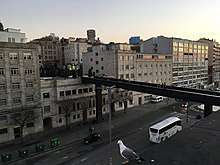
The city of Vigo has 293,642 inhabitants (2018) with an extended metropolitan population of 478,508, in a southern part of the province of Pontevedra making it Spain's 14th-largest metropolitan area.
In 2019, 15,319 foreigners lived in the city, 5.2% of the total population. The main nationalities are Portuguese (12%), Venezuelans (9.2%)Brazilians (9%), Romanians (7.5%), Colombians (6.5%), Senegal (4%) and Chinese people (3%).
By language, according to 2013 data, 7.68% of the population speak exclusively in Galician, and 51.39% in Spanish; 11.38% speak in Galician more often than Spanish, and 29.55% more often in Spanish than Galician. This makes Vigo the least Galician-speaking city in Galicia.[10]
The creation of Vigo Metropolitan Area was approved in 2016 and,[11] in addition to Vigo, it originally accounted for the following 13 municipalities: Baiona, Cangas, Fornelos de Montes, Gondomar, Moaña, Mos, Nigrán, Pazos de Borbén, O Porriño, Redondela, Salceda de Caselas, Salvaterra de Miño and Soutomaior.[12] It has been however suspended since its creation.[11] The European Union's Directorate-General for Regional and Urban Policy assigns Vigo a wider functional urban area (FUA), with 21 municipalities and a population of 541,000 inhabitants.[13]
Government and administration
Vigo is a municipality, the basic level of local government in Spain. The Ayuntamiento (concello in Galician) is the body charged with the municipal government and administration. The Plenary of the concello is formed by 27 elected municipal councillors, who in turn invest the mayor.
The last municipal election took place on 26 May 2019, leading to a plenary formed by 20 councillors from the Socialists' Party of Galicia–PSOE, 4 from the People's Party, 2 from the Marea de Vigo and 1 from the Galician Nationalist Bloc.[14] The current mayor is Abel Caballero (Spanish Socialist Workers Party), who has won four mandates in a row since becoming mayor in 2007.[15]
Parishes
Vigo is administratively divided into 23 parroquias ("parishes").
- Alcabre: Ameixeira, Barreiro, Carregal, Castañal, Cristo, Forte, Gándara, Igrexa, Pardaíña, Roade, Sobreira, Viñagrande
- Beade: Babio, Balde, Carballo do Pazo, Coutada, Gándara, Porto, A Pena, Quintián, O Seixo, A Venda, Sáa
- Bembrive: Baruxans, Carballal, Chans, Xestoso, Mosteiro, Outeiro, San Cibrán, Segade, Areeiro, Eifonso, Mouteira, Recaré, Xesteira
- Bouzas
- Cabral: Becerreira, Carballal, Sello, Figueiras
- Candeán: Igrexa, Candeán de Arriba, Rabadeira, Fonte Oscura
- Castrelos: Alvite, Castreliños, Costa, Chantada, Espedrigada o Pereiró, A Pousa, Falcoa, Macal, Pazó, Portoloureiro, Viloura
- Coia
- Comesaña: Casas, Cocheiros, Comesaña, Eidos, Igrexa, Muíños, Pazo, Pedra Branca, Pedreira, Pereiras, Ponte, Romeu, Rodeira, Sanin, Tombo, Viña da Veiga
- Coruxo: Roteas, Río, Molans, Cean, Fontela, Breadouro, Silveira, Combro, Calzada, Cotarelo, Romeu, Verdeal, Melcas, Taberna, Burdes, Abade, Igrexa, Quintas, Carballal, Rozo, Coto de Arriba, Coto de Abaixo, Carrasqueira, Muiños, Gándara, Longra, Luz, Bouzas, Tarrío, Gato, San Lourenzo, Torre de Abaixo, Torre de Arriba, Laxes, Viño, Pedreira, Parrocha, Fragoselo, Tintureira
- Freixeiro: Mantelas, A Salgueira, Riobó
- Lavadores: Arriero, A Bagunda, Barreiro, Cambeses, A Ceboleira, O Couto, Gandariña, Gandarón, Naia, Pardavila, Riomaio, San Paio de Abaixo, San Paio, Igrexa
- Matamá: Balsa, Balvis, Barxa, Beirán, Campos, Carapuxa, Carneiras, Dehesa, Castro, Igrexa, Lagarella, Moo, Outeiro, Parada, Pazos, Pereiro, Revolta, Rivas, Ribelas, Roupeiro, San Amaro, Vilar
- Navia: Devesa, Gándara, Goberna, Pereiras, Quintela, Redondo, Samil, Tomada, Torre, Xuncal
- Oia: Bouzo, Cabo Estai, Canido Praia, Carretera Cortada, Cerqueiro, Cruceiro, Curras, Eiras, Estea, Esteriz, Estomada, Figueiras, Gontade, Grades, Hermida, Igrexa, Loureiro, Estación, Lantexa, Lavandeira, Liñares, A Maris, Matoca, Mide, Oia, Outeiro, Poza, Rochas, Rozo, Senra de Arriba, Senra de Abaixo, Silval, Toxal, Toucido, Verdella, Xistro
- Saiáns: Carballido, Cal do Outeiro, Garcias, Aral, Fontán, Gándara, Cova da Becha, Curbeira, Horta, Orxas, Castañal, Borreiros, Portiño, Tomada, San Xurxo, Capela, Misarelas, Estea, Pinal, Budiases, Souto, Cova da Barxa, Domeira, Cachoa, Dovesa, Fortiñon, Gondufe, Volta, Vilaverde
- San Paio
- San Xoán do Monte
- Sárdoma
- Teis: Cacharela, Mouta, Ferreira, Paradela, Fervenza, Ríos, Travesán, Presa, Chumba, Igrexa, Trapa, Arnel, Praixal, Rorís, Balbarda, A Guía, Oliveira, Espiñeiro, Frian, Santa Tegra, Bellavista, Calzada, Coutadas, Os Caños, Tovel, A Rabuda, Guixar, Barrio das Frores, Montecelo
- Valadares
- Vigo centro
- Zamáns: Casal de Abade, Cidáns, A Igrexa (San Mamede), As Lagoas, Marcosende, A Menda, Paredes, Vilariño, Vilaverde, Erville.
Main sights
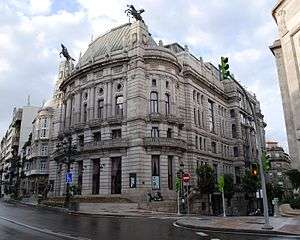
An industrial and recent city, Vigo has few remarkable old buildings but is home to a collegiate church and a few museums, most of which were inaugurated between the late 1990s and early 2000s. Among them, the Museum of Contemporary Art (MARCO) and the Museum of the Sea. The oldest museum is the Quiñones de León Municipal Museum. The most important historical centre of the region is located in its capital and rival city, Pontevedra.

- Casco Vello (historic centre)
- Porta do Sol, Policarpo Sanz and Alameda area (modern centre)
- Príncipe and Urzaiz Streets (commercial area)
- Celtic Castro ruins
- Castro fortress
- Collegiate church of Santa Maria de Vigo
Museums
- Naturnova Museum: Museum dedicated to the environment. Interactive contents.
- Museum of the Sea: Museum dedicated to the Sea, and to tinned food and to naval. Important building designed by famous architects Aldo Rossi and Cesar Portela.
- Museum of Contemporary Art, Vigo: One of the most important museums of Contemporary Art in Spain.
- Museum of Castrelos.
- Verbum, Casa das Palabras. A museum dedicated to languages and communication. Important building designed by famous architect Cesar Portela.
- Pinacoteca de Vigo
- Galician Center of Photography
- Ethnographic Museum Liste
- Pedro Barrié de la Maza Foundation
Romanesque architecture of Vigo
The municipality of Vigo is not only one of the major industrial cities in Galicia, but it is also one of the more important Roman centers of Pontevedra. Although within the city one will not find much Romanesque architecture, it can be seen a few kilometers away from the city center. In many of the municipality's neighborhoods and parishes a large number of Roman ruins remain. Such is the importance of the Roman remains in Vigo that many Spanish authors have come to coin the term Romanesque Vigo (románico vigués in Spanish). Vigo retains some interesting examples of Romanesque churches in southern Galicia:[16]
- Santa María de Castrelos
- Santiago de Bembrive
- San Salvador de Coruxo
Beaches
- Samil beach
- Carril beach
- Canido beach
- Vao beach
Transport
- Airport
Vigo is served by Vigo-Peinador Airport (VGO/LEVX). Located to the east of the city of Vigo, straddling halfway the municipalities of Vigo, Redondela and Mos, it offers 7 domestic destinations.
- Ferry
A ferry service operates between the Port of Vigo and the towns of Cangas and Moaña as well as the Cíes Islands, 15 kilometres away from the city, part of the Atlantic Islands of Galicia National Park, the only National Park in Galicia, which includes Ons Island in the Pontevedra Bay.
- Rail transport
The Urzáiz and Guixar railway stations serve Vigo, allowing direct connections to the rest of Galicia as well as to Porto across the border in Portugal.
- Road
European route E01 goes through the town. This highway goes south through Lisbon and north to the A Coruña area.
The A-52 road goes inland, east to Ourense and Madrid from O Porriño. A branch of the AP-9 Motorway connects Vigo to Portugal in the south and with Pontevedra, Santiago de Compostela, A Coruña and Ferrol in the north.
- Public transport
Urban transport is provided by buses by Vitrasa progestin.
Economy
_no_porto_pesqueiro_de_Vigo.jpg)
.jpg)
Vigo is characterized by a diversified economy linked to the fishing sector, industry, trade, tourism and services. It is often considered with A Coruña one of the economic and industrial engines of Galicia.
Vigo is one of the leading industrial areas in Galicia, with a French car factory, shipyards, and auxiliary industry in both automotive and marine sectors. Situated in Vigo, the French factory PSA Peugeot Citroën since 1958, in 2007 produced a total of 545,000 vehicles, of which more than 82% were sold outside Spain.
In addition, Vigo has a fishing port and is the home port of one of the world's largest fishing company, Pescanova and the most important centre of the Galician canned fish industry. The headquarters of the European Fisheries Control Agency are also located in the city.
The publishing industry in Galician is prominent in the city, with Editorial Galaxia and Editorial Xerais.
Port of Vigo
The Port of Vigo covers a length of more than 20 km and offers more than 9 km of docks. The largest port traffic is general freight, highlighting container traffic, RO-RO of vehicles (the second in Spain in Ro-Ro traffic for new vehicles), natural stone and granite (the first of Spain in granite traffic), wood and preserved food.
Education
The University of Vigo is located in a mountainous area 15 kilometres away from the city, in the parish of Zamáns.[17] It is a center for studies related to ocean-based industries. The university has additional campuses in Pontevedra and Ourense.
The University of Vigo was founded in 1990 as split from the University of Santiago de Compostela.[18] The Zamáns Campus features several examples of modern architecture, projected by the likes of Enric Miralles, Alfonso Penelas, Pilar Díez y Alberto Noguerol César Portela, Gabriel Santos Zas and César Padrón.[19]
Culture
Music
A movida viguesa was a hedonistic cultural movement akin to the Movida madrileña that took place in Vigo during the 1980s triggered by the explosion of liberties after the death of dictator Francisco Franco. The most important artists of this postmodern movement were musicians; particularly punk and new wave bands such as Siniestro Total, Golpes Bajos, Aerolíneas Federales, Semen Up or Os Resentidos.
At the moment, the city still has notorious bands like Iván Ferreiro (ex-singer of Los Piratas) and Mon.
Media and entertainment
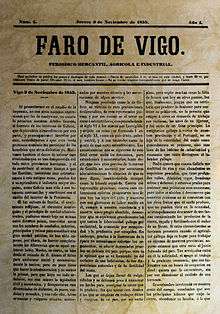
Vigo has two daily newspapers; the Faro de Vigo, the oldest newspaper in Spain still in circulation, and the Atlántico Diario, a little local newspaper. There also exist a local edition of the Galician main headline newspaper "La Voz de Galicia". Vigo was also the main location of historic newspaper such as the nationalist weekly newspaper "A Nosa Terra", now defunct (published from 1977 to 2011).
Vigo also has a TV local station: "Televigo".
Radio coverage includes RNE —the Spanish public radio network—, Radio Galega —a Galician government-supported radio in Galician language—, and some private-owned stations ("Radio Vigo - Cadena Ser", "Radio Voz Vigo", "Radio ECCA", and so on).
Around 2000s, several online news websites emerged (for example, "riadevigo.com") besides of the traditional media homepages. Vigo also participated in the Europeanwide free newspapers rush led by "Metro" and some free journals were published in 1990s and 2000s: "20 minutos", "Gaceta Universitaria", "Redacción Xove", etcetera. "España Exterior" is also printed in Vigo.
The locally produced award-winning feature movie Mondays In The Sun (original title Los lunes al sol) depicts the life of several men who have lost their work at the Port of Vigo. This film is not based on a single individual's experiences but on the perceived collective experiences of many local port workers.
Sports
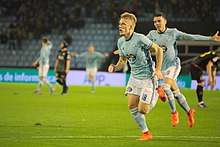
Vigo has one of the most important women's basketball team in Spain, Celta, more commonly referred to today by its sponsorship name of Celta Indepo. They usually compete in the top league of women's basketball, having won the championship three times. For the season 2012–2013, and following a number of economic problems, the team will play in the Spanish women basketball second division.
Vigo has a football team, Real Club Celta de Vigo, which (as of 2019–20) plays in La Liga. The women's team from the area, Federación Viguesa de Peñas Recreativas El Olivo, was the first team from Galicia to compete in the Women's Primera División.[20]
The Rías Baixas offer an excellent environment for nautical sports. Institutions such as the Real Club Nautico de Vigo (RCNV), founded in 1906, and the Liceo Marítimo de Bouzas (LMB), founded in 1907, are good examples of promotion of the nautical sports, especially sailing.
.jpg)
The RCNV organises important events like Atlantic Week, which in September 2006 included the World Championship of the Platu 25 class. Every August, the RCNV also organises one of the largest sailboat races in the Iberian peninsula: the Regata Rías Baixas. In 2006 more than 130 different boats participated.
The LMB is a yacht club which counts around 400 associates. The LMB has a long and intense history of sailing and recreational fishing. The LMB organizes two important regattas in the Galician sailing calendar: the Regata Vila de Bouzas and a Regata de Solitarios y a Dos.
The Regata Vila de Bouzas honours the neighbourhood where the LMB is located. The Regata de Solitarios y a Dos is sponsored by the firm Aister and is for crews of one and two members. It is a difficult race with two stages; the first consists of a race through the coastal bay of Vigo while the second stage is a longer race around the Cies Islands (and/or Ons Islands). The LMB has schools of sailing and fishing. Yearly it organizes a cephalopods fishing competition.
Notable people
- Dores André, ballet dancer
- José María de Azcárate, art historian, author, researcher, curator, and professor, specializing in medieval Castilian art and Renaissance sculpture.[21] Born in Vigo.[21]
- Antonio M. Pérez, CEO of Eastman Kodak
- Carlos Núñez, musician
- Méndez Núñez, military officer
- Concepcion Picciotto, peace activist
- Francisco Marcó del Pont, last governor of Chile under Spanish rule
- Iago Falque, footballer
- Iván Ferreiro, singer-songwriter
- Manuel Manquiña, actor
- Martín Codax, poet
- Domingo Villar, author
- Ramón Souto, composer
- Ricardo Mella, anarchist activist
- Ignacio Ramonet Miguez, journalist and activist, editor-in-chief of Le Monde Diplomatique (1991-2008)
- Roberto Losada Rodríguez, footballer
- Serafín Avendaño, painter
In popular culture
- Vigo Bay is one of the settings for Jules Verne's novel Twenty Thousand Leagues Under the Sea. The book's protagonist, Captain Nemo, draws his wealth and the funding for his submarine Nautilus from the cargoes of the galleons sunk by the British during the Battle of Vigo Bay in 1702. They are depicted as still having their treasure and as being easily accessible to divers.[22]
- In the movie Das Boot, set during World War II, the German submarine U-96 stops in Vigo for supplies and torpedoes.
International relations
- Twin towns and sister cities
Vigo has reached twin town, sister city agreements with:
- 1983 — Lorient (France).[23]
- 1984 — Narsaq (Greenland).[24]
- 1986 — Porto (Portugal).[25][26]
- 1992 — Buenos Aires (Argentina).[27][24]
- Victoria de Durango (Mexico).[28]
- Caracas (Venezuela).
- Las Palmas de Gran Canaria (Spain).[29]
See also
References
- Municipal Register of Spain 2018. National Statistics Institute.
- "Consolidation Top down and Bottom up Analysis" (PDF). p. 9.
- "Vigo". galiciaguide.com. Retrieved 17 November 2010.
- "Vigo". Retrieved 5 July 2013.
- "Extreme Values for Vigo Airport". Aemet.es. Retrieved 22 July 2015.
- "Décembre 1978 á Vigo" (in French). Météo Climat. Retrieved 2 February 2018.
- "Extreme values for Vigo Airport". Aemet.es. Retrieved 22 July 2015.
- "Standard climate values for Vigo Airport". Aemet.es. Retrieved 22 July 2015.
- "Guía resumida del clima en España (1981-2010)".
- Instituto Galego de Estatística.
- Pita, E.V. (16 October 2018). "El Área Metropolitana de Vigo seguirá suspendida para evitar perjuicios a los ciudadanos". La Voz de Galicia.
- Comunidad Autónoma de Galicia: "Ley 4/2012, de 12 de abril, del Área Metropolitana de Vigo" (PDF). Boletín Oficial del Estado. 2012-04-09. ISSN 0212-033X.
- Punzón, Carlos (18 June 2018). "La UE dibuja un área funcional de Vigo con 541.000 habitantes". La Voz de Galicia.
- Junta Electoral Central: "Resolución de 10 de septiembre de 2019, de la Presidencia de la Junta Electoral Central, por la que se procede a la publicación del resumen de los resultados de las elecciones locales convocadas por Real Decreto 209/2019, de 1 de abril, y celebradas el 26 de mayo de 2019, según los datos que figuran en las actas de proclamación remitidas por cada una de las Juntas Electorales de Zona. Provincias: Navarra, Ourense, Palencia, Las Palmas, Pontevedra y La Rioja" (PDF). Boletín Oficial del Estado: 101665. ISSN 0212-033X.
- Paniagua, Ángel; Punzón, Carlos (15 June 2019). "Caballero declara abierta la era de su "mayoría absolutísima"". La Voz de Galicia.
- "Igrexas Romanicas en Vigo". Archived from the original on 31 July 2008. Retrieved 2 May 2012.
- "Vigo tiene que pagar 462.000 € a Zamáns por construir el Cuvi". Atlantico. 8 April 2015.
- Estévez, José Luis (11 December 2003). "La ciudad universitaria de Vigo incorpora el "paisaje construido" de Enric Miralles". El País.
- Lamas, Jorge (18 August 2015). "Un paseo por la mejor arquitectura contemporánea". La Voz de Galicia.
- "Quiero que sepan que hay futuro en el fútbol femenino". lavozdegalicia.es. Retrieved 2011-12-09.
- "Azcárate y Ristori, José María". Museo Nacional del Prado (in Spanish). Retrieved 2018-11-26.
- Verne, Jules (1871). "Twenty Thousand Leagues Under the Seas". J. Hetzel et Cie. Retrieved 2014-02-22.
- "Vigo y Lorient se hermanan". La Voz de Galicia. 19 February 2016.
- Rolland, Eduardo (24 March 2013). "Nuestros hermanos esquimales". La Voz de Galicia.
- "International Relations of the City of Porto" (PDF). 2006-2009 Municipal Directorate of the Presidency Services International Relations Office. Archived from the original (PDF) on 2010-02-15. Retrieved 2009-07-10.
- Andrés, José Teo de (24 October 2016). "Vigo y Oporto cumplen 30 años de hermanamiento". Atlantico.
- "Decreto nº 1066. Declarase a la ciudad de Vigo del Reino de España "Ciudad Hermana de Buenos Aires"" (PDF).
- "Políticos y empresarios de Vigo viajarán a Celaya en noviembre". September 26, 2014. Retrieved May 20, 2020.
- Mariño, A. (June 2, 2010). "Sorpresa en Las Palmas por el hermanamiento con Vigo". Atlántico Diario. Retrieved May 20, 2020.
External links
| Wikimedia Commons has media related to Vigo. |
| Wikivoyage has a travel guide for Vigo. |
- . Encyclopædia Britannica. 28 (11th ed.). 1911. p. 62.
- Official city site
- Info about Vigo at Spanish Tourism Board Official Website
.jpg)